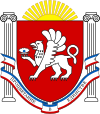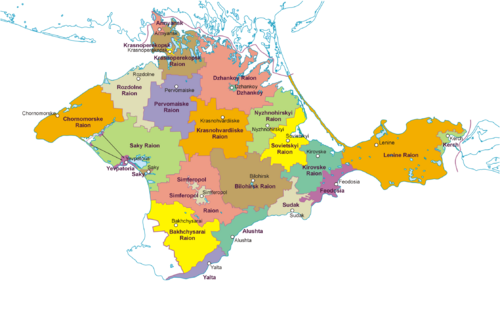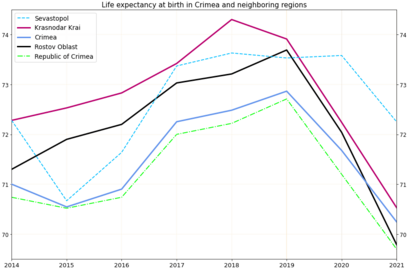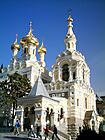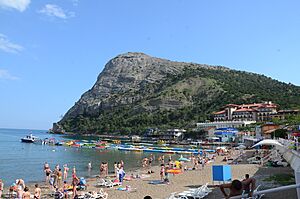Republic of Crimea (Russia) facts for kids
Quick facts for kids
Republic of Crimea
|
|||
|---|---|---|---|
|
Republic
|
|||
|
|||
| Anthem: Нивы и горы твои волшебны, Родина Nivy i gory tvoi volshebny, Rodina (Russian) "Your fields and mountains are magical, Motherland" |
|||

Location of the Republic of Crimea (Russia) (red)
in Russia (light yellow) |
|||

Location of the Republic of Crimea (Russia) (light yellow)
in the Crimean Peninsula |
|||
| Federal district | Southern | ||
| Economic region | North Caucasus | ||
| Capture of the Crimean parliament by Russian forces | 27 February 2014 | ||
| Annexation by Russia | 18 March 2014 | ||
| Administrative centre | Simferopol | ||
| Government | |||
| • Body | State Council | ||
| Area | |||
| • Total | 26,081 km2 (10,070 sq mi) | ||
| Population
(2021)
|
|||
| • Total | 1,934,630 | ||
| • Density | 74.1778/km2 (192.120/sq mi) | ||
| Languages | |||
| • Official | |||
| Time zone | UTC+3 (MSK) | ||
| License plates | 82 | ||
The Republic of Crimea is a republic of Russia, comprising most of the Crimean Peninsula, but excluding Sevastopol. Its territory corresponds to the pre-2023 territory of the Autonomous Republic of Crimea, a de jure subdivision of Ukraine. Russia occupied and annexed the peninsula in 2014, although the annexation remains internationally unrecognized.
The capital and largest city located within its borders is Simferopol, which is the second-largest city on the Crimean Peninsula. As of the 2021 Russian census, the Republic of Crimea had a population of 1,934,630.
Contents
Government and politics
The State Council of Crimea is a legislative body with a 75-seat parliament. The polling held on 14 September 2014 resulted in United Russia securing 70 of the 75 members elected.
Justice is administered by courts, as part of the judiciary of Russia. Under Russian law, all decisions delivered by the Crimean branches of the judiciary of Ukraine up to its annexation remain valid. This includes sentences (for "encroaching on Ukraine's territorial integrity and inviolability") for pre-2014 calls for an incorporation of Crimea into Russia.
The executive power is represented by the Council of Ministers, headed either by the Prime Minister of Crimea or by the Head of the Republic of Crimea. The authority and operation of the State Council and the Council of Ministers of Crimea are determined by the Constitution of the Republic of Crimea and other Crimean laws, as well as by regular decisions carried out by the Council.
Crimeans who refused to take Russian citizenship are barred from holding government positions or municipal jobs.
By July 2015, 20,000 Crimeans had renounced their Ukrainian citizenship. From the time of Russia's annexation until October 2016, more than 8,800 Crimean residents received Ukrainian passports.
On 18 September 2016, the whole of Crimea participated in the Russian legislative election.
Military
- Marine Corps of the Russia "little green men"
- Baherove (air base)
- Theodosius-13
- Southern Naval Base
Administrative divisions
The Republic of Crimea continues to use the administrative divisions previously used by the Autonomous Republic of Crimea and is thus subdivided into 25 regions: 14 districts (raions) and 11 city municipalities (gorodskoj sovet or gorsovet), officially known as territories governed by city councils.
Geography and demographics
Crimea's only land boundary is with mainland Ukraine, which continues to claim sovereignty over the peninsula, with a number of road and rail connections. These crossings have been under the control of Russian troops since at least mid-March 2014.
Crimea has no land connection to Russia. In 2014–2019, Russia built the Crimean Bridge, a multibillion-dollar road–rail fixed link across the Kerch Strait. The link has been open for road traffic since 2018, and for rail traffic since 2019 (passenger) and 2020 (freight). In October 2022 it was badly damaged by an explosion.
Life expectancy
According to the Russian occupation authorities, the best result in life expectancy the Republic of Crimea had in 2019, it reached 72.71 years. But during two years the COVID-19 pandemic the region had one of the largest summary fall in life expectancy in Russia, and in 2021 it became 69.70 years (65.31 for males and 73.96 for females)
Languages
According to the Constitution of the Republic of Crimea:
Article 10
1. Official languages of the Republic of Crimea are Russian, Ukrainian and Crimean Tatar.
According to the 2014 census by occupation authorities, 84% of Crimean inhabitants named Russian as their native language; 7.9% named Crimean Tatar; 3.7% Tatar and 3.3% Ukrainian. The previous census was held more than decade ago in 2001, when Crimea was still controlled by Ukraine.
According to the Republic of Crimea Ministry of Education, Science, and Youth, most primary and secondary school pupils have decided to study in Russian in 2015.
- In Russian – 96.74%
- In Crimean Tatar – 2.76%. 5083 pupils (+188 to 2014 year) study in Crimean Tatar language in 53 schools in 17 districts. 37 1st grade classes of primary school have been opened.
- In Ukrainian – 0.5%. 949 pupils study in Ukrainian language in 22 schools in 13 districts. 2 1st grade classes of primary school have been opened.
Its Education Minister Natalia Goncharova announced mid-August 2014 that (since no parents of first-graders wrote an application for learning Ukrainian) Crimea had decided not to form Ukrainian language classes in its primary schools. Goncharova said that since more than a quarter of parents at the Ukrainian gymnasium in Simferopol had written an application to teach children in Ukrainian; this school might have Ukrainian language classes. Goncharova also added that the parents of first-graders had written application for learning the Russian language, and (in areas inhabited by Crimean Tatars) for learning Crimean Tatar. Goncharova stated on 10 October 2014 that at that time Crimea had 20 schools where all subjects were conducted in Ukrainian.
A report (realised in the summer of 2015) of the Organization for Security and Cooperation in Europe (OSCE) stated that the Republic of Crimea had the aim to "end the teaching of Ukrainian" by "pressure on school administrations, teachers, parents, and children".
Religion
In 2013, before the Russian occupation, the majority of the Crimean population adhered to the Orthodox Church, with the Crimean Tatars forming a Sunni Muslim minority, besides smaller Roman Catholic, Ukrainian Greek Catholic, Armenian Apostolic and Jewish minorities. In 2013, Orthodox Christians made up 58% of the Crimean population, followed by Muslims (15%, mainly Tatars) and believers without religion (10%).
Since 2014, the United Nations has reported a regime of human-rights violations imposed by the Russian occupation authorities, including targeting religious minority groups and individuals.
Economy
Peninsula economy is based on tourism, agriculture (wines, fruits, wheat, rice and further crops), fishing, pearls, mining and natural resources (mainly iron, titanium, aluminium, manganese, calcite, sandstone, quartz and silicates, amethyst, other), metallurgical and steel industry, shipbuilding and repair, oil gas and petrochemical, chemical industry, electronics and devices machinery, instruments making, glass, electronics and electric parts devices, materials and building.
Tourism
In 2014 about two million tourists holidayed in Crimea, including 300,000 Ukrainians. In 2013 3.5 million Ukrainian and 1.5 million Russian tourists visited Crimea. Tourism is the mainstay of the Crimean economy. In August 2014 Head of the Republic Aksyonov was confident that in 2015 Crimea would welcome "at least five million visitors – I have no doubts about that". Early August 2015 the press service of his government stated that in 2015 2.02 million tourists had visited Crimea (16.5% more than in 2014). They stated in January 2016 (that in 2015) more than 4 million tourists had vacationed in the peninsula. Over 6.4 million tourists visited Crimea in 2018, according to occupation authorities. Some tourists went home after an airbase attack in August 2022. Crimean Bridge explosion also influenced the tourists.
Museums and art galleries
- Aivazovsky National Art Gallery
- Alexander Grin house museum
- Feodosia Money Museum
- Lapidarium, Kerch
- Livadia Palace
- Massandra Palace
- Simferopol Art Museum
- Museum of Vera Mukhina
- Vorontsov Palace (Alupka)
- White Dacha
Industrial Park
- Feodosia Industrial Park
- Bakhchysarai Industrial Park
Telecommunication
The internet connection goes via Krasnodar Krai.
In Crimea Peninsula worked four mobile operators already offers voice and mobile data for 2G, 3G and 4G users.
Transport
Aviation
Simferopol is an air transport hub of the Republic of Crimea.
- Simferopol International Airport
Rail
- Crimea Railway
Trolleybus Line
Crimean trolleybus line length of 86 kilometres (53 mi) long of service «Krymtrolleybus».
Routes: Airport Simferopol — Simferopol — Alushta — Yalta
Roads
- European route E105 – Syvash – Dzhankoy – North Crimean Canal – Simferopol – Alushta – Yalta
- Tavrida Highway A291: Kerch — Feodosia — Belogorsk — Simferopol — Bakhchisarai — Sevastopol.
- European route E97: Dzhankoy – Feodosiya – Kerch.
- Novorossiysk — Kerch highway A290: Crimean Bridge — Kerch
- Highway H19 (Ukraine) – Yalta – Sevastopol
- Highway M18 (Ukraine) – Yalta – Simferopol – Dzhankoy
- Highway H05 (Ukraine) – Simferopol – Simferopol International Airport – Krasnoperekopsk.
Water
- Kerch Strait ferry line (until 2020), Kerch–Yenikale Canal
Education
Although Russian, Ukrainian and Crimean Tatar languages have official status, reports say that Ukrainian and Crimean Tatar education is being squeezed.
Sport
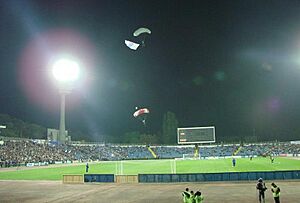
Football clubs
- FC TSK Simferopol
- FC Krymteplytsia Molodizhne
- FC Ocean Kerch
- FC Rubin Yalta
See also
 In Spanish: República de Crimea para niños
In Spanish: República de Crimea para niños



